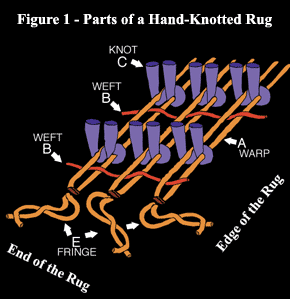Creating a Rug
Creating a hand-woven rug is a complicated task, requiring a variety of distinct skills and techniques. Needless to say, the process is both labor-intensive and time-consuming. 
First, the raw wool must be washed, carded, and spun into yarn. The yarns are then carefully dyed. The range and subtlety of the yarn colors, and their interplay in a given design, are obviously crucial to the appeal and unique character of the finished rug. Along with the actual weaving and execution of a chosen pattern, the dyeing process is traditionally entrusted only to the most skillful craftsmen.
From the dawn of rug-making until relatively recent times, the only available dyes were derived from animal and vegetal sources. While often quite vibrant initially, some of these dyes were inclined to fade over time. In many cases, this effect would enhance the harmony of the color palette and lend a soft vintage quality to the rug. Some natural dyes, however, could weaken the wool fiber and result in uneven patterns of wear and color intensity over time.
Beginning in the 19th Century, chemical formulations began to replace natural dyes in commercial usage. Chemical dyes gave the weaver a vast and infinitely varied color palette, from the richest and deepest jewel tones to the most delicate and subtle pastels. Equally important, chemical dyes are more fade-resistant and will not compromise the fibers of the yarn.
Once the yarns for a rug are spun and dyed, the loom is prepared for the weaving process. Historically, nomadic tribes used horizontal looms which rest on the ground or, occasionally, transportable vertical looms. Today, most quality rugs made for export are woven on large "roller beam" looms. Whatever type of loom is used, the basic principles of rug-making remain essentially the same. The vertical "warp" threads are tied between the loom's upper and lower beams, and define the rug’s length. The horizontal "weft" threads are woven between the alternating warps across the rug, and define the rug’s width.
In a knotted rug, tiny threads are tied onto the warp, creating the pattern or design. The weft threads anchor and align the rows of knots. When the knots are later cut, they stand away from the warp/weft backing to create the velvety pile of the finished piece. (See Figure 1 above)